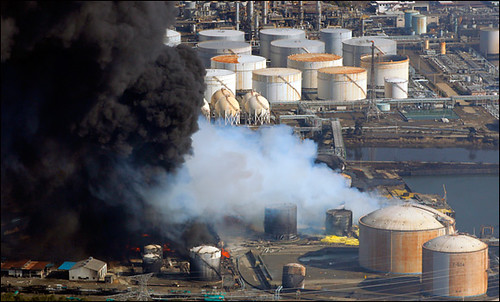
A nuclear power plant damaged during the Japanese earthquake and tsunami. The authorities in Japan say that the damage done at the plants may include a partial meltdown on the reactors. a photo by Pan-African News Wire File Photos on Flickr.
Published: March 16, 2011 00:55 IST | Updated: March 16, 2011
02:00 IST TOKYO/HONG KONG/WASHINGTON, March 16, 2011
Radiation spreading from crippled reactors
In anmage made off Japan's NTV/NNN Japan television footage, smoke ascends from the Fukushima Daiichi nuclear plant's Unit 3 in Okumamachi, Fukushima Prefecture, northern Japan, on Monday.
Japan's nuclear crisis verged toward catastrophe on Tuesday after an explosion damaged a vessel containing the nuclear core at one reactor and a fire at another spewed large amounts of radioactive material into the air, according to the statements of Japanese government and industry officials.
(An AFP report said a magnitude 6.0 quake rattled Tokyo late on Tuesday. The epicentre was located in Shizuoka prefecture, about 120 km southwest of the capital.)
In a brief address to the nation at 11 a.m. Tokyo time, Prime Minister Naoto Kan pleaded for calm, but warned that radiation had spread from the crippled reactors and there was “a very high risk” of further leakage. Fortunately, the prevailing winds were sweeping most of the plume of radioactivity out into the Pacific Ocean, rather than over populated areas.
The sudden turn of events, after an explosion on Monday at one reactor and an early-morning explosion on Tuesday at yet another, the third in four days, at the plant already made the crisis at the Fukushima Daiichi Nuclear Power Station the worst nuclear accident since the Chernobyl reactor disaster a quarter-century ago.
It diminished hopes earlier in the day that engineers at the plant, working at tremendous personal risk, might yet succeed in cooling down the most damaged of the reactors, No. 2, by pumping in sea water. According to government statements, most of the 800 workers at the plant had been withdrawn, leaving 50 or so workers in a desperate effort to keep the cores of three stricken reactors cooled with seawater pumped by firefighting equipment, while the same crews battled to put out the fire at the No. 4 reactor, which they claimed to have done just after noon.
That fourth reactor had been turned off and was under refurbishment for months before the earthquake and tsunami hit the plant on Friday. But the plant contains spent fuel rods that were removed from the reactor, and experts guessed that the pool containing those rods had run dry, allowing the rods to overheat and catch fire. That is almost as dangerous as the fuel in working reactors melting down, because the spent fuel can also spew radioactivity into the atmosphere.
The two critical questions over the next day or so are how much radioactive material is spewed into the atmosphere, and where the winds carry it. Readings reported on Tuesday showed a spike of radioactivity around the plant that made the leakage categorically worse than it had been, with radiation levels measured at one point as high as 400 millisieverts an hour. Even seven minutes of exposure at that level will reach the maximum annual dose that a worker at a U.S. nuclear plant is allowed. And exposure for 75 minutes would likely lead to acute radiation sickness.
In Tokyo, 170 miles south of the plant, the metropolitan government said on Tuesday that it had detected radiation levels 20 times above normal over the city. In Ibaraki prefecture, just south of Fukushima prefecture where the plant is located, the amount of radiation reached 100 times the usual levels. — New York Times News Service
No comments:
Post a Comment